Long-lasting potentiation of GABAergic synapses in dopamine neurons after a single in vivo ethanol exposure
- PMID: 11896147
- PMCID: PMC6758244
- DOI: 10.1523/JNEUROSCI.22-06-02074.2002
Long-lasting potentiation of GABAergic synapses in dopamine neurons after a single in vivo ethanol exposure
Abstract
The mesolimbic dopamine (DA) system originating in the ventral tegmental area (VTA) is involved in many drug-related behaviors, including ethanol self-administration. In particular, VTA activity regulating ethanol consummatory behavior appears to be modulated through GABA(A) receptors. Previous exposure to ethanol enhances ethanol self-administration, but the mechanisms underlying this phenomenon are not well understood. In this study, we examined changes occurring at GABA synapses onto VTA DA neurons after a single in vivo exposure to ethanol. We observed that evoked GABA(A) IPSCs in DA neurons of ethanol-treated animals exhibited paired-pulse depression (PPD) compared with saline-treated animals, which exhibited paired-pulse facilitation (PPF). Furthermore, PPD was still present 1 week after the single exposure to ethanol. An increase in frequency of spontaneous miniature GABA(A) IPSCs (mIPSCs) was also observed in the ethanol-treated animals. Additionally, the GABA(B) receptor antagonist (3-aminopropyl)(diethoxymethyl) phosphinic acid shifted PPD to PPF, indicating that presynaptic GABA(B) receptor activation, likely attributable to GABA spillover, might play a role in mediating PPD in the ethanol-treated mice. The activation of adenylyl cyclase by forskolin increased the amplitude of GABA(A) IPSCs and the frequency of mIPSCs in the saline- but not in the ethanol-treated animals. Conversely, the protein kinase A (PKA) inhibitor N-[z-(p-bromocinnamylamino)ethyl]-5-isoquinolinesulfonamide significantly decreased both the frequency of spontaneous mIPSCs and the amplitude of GABA(A) IPSCs in the ethanol-treated mice but not in the saline controls. The present results indicate that potentiation of GABAergic synapses, via a PKA-dependent mechanism, occurs in the VTA after a single in vivo exposure to ethanol, and such potentiation might be a key synaptic modification underlying increased ethanol intake.
Figures

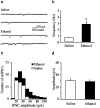
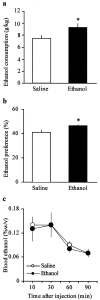
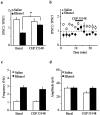
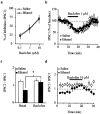
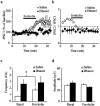
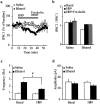
Similar articles
-
Ethanol dually modulates GABAergic synaptic transmission onto dopaminergic neurons in ventral tegmental area: role of mu-opioid receptors.Neuroscience. 2008 Apr 22;153(1):240-8. doi: 10.1016/j.neuroscience.2008.01.040. Epub 2008 Feb 6. Neuroscience. 2008. PMID: 18343590 Free PMC article.
-
Ethanol blocks long-term potentiation of GABAergic synapses in the ventral tegmental area involving mu-opioid receptors.Neuropsychopharmacology. 2010 Aug;35(9):1841-9. doi: 10.1038/npp.2010.51. Epub 2010 Apr 14. Neuropsychopharmacology. 2010. PMID: 20393452 Free PMC article.
-
Ethanol enhances GABAergic transmission onto dopamine neurons in the ventral tegmental area of the rat.Alcohol Clin Exp Res. 2008 Jun;32(6):1040-8. doi: 10.1111/j.1530-0277.2008.00665.x. Epub 2008 Apr 15. Alcohol Clin Exp Res. 2008. PMID: 18422836 Free PMC article.
-
LTP of GABAergic synapses in the ventral tegmental area and beyond.J Physiol. 2008 Mar 15;586(6):1487-93. doi: 10.1113/jphysiol.2007.148098. Epub 2007 Dec 13. J Physiol. 2008. PMID: 18079157 Free PMC article. Review.
-
The role of GABA(A) receptors in the acute and chronic effects of ethanol: a decade of progress.Psychopharmacology (Berl). 2009 Sep;205(4):529-64. doi: 10.1007/s00213-009-1562-z. Epub 2009 May 20. Psychopharmacology (Berl). 2009. PMID: 19455309 Free PMC article. Review.
Cited by
-
NMDA receptor antagonism: escalation of aggressive behavior in alcohol-drinking mice.Psychopharmacology (Berl). 2012 Nov;224(1):167-77. doi: 10.1007/s00213-012-2734-9. Epub 2012 May 16. Psychopharmacology (Berl). 2012. PMID: 22588250 Free PMC article.
-
Classic psychedelics and alcohol use disorders: A systematic review of human and animal studies.Addict Biol. 2022 Nov;27(6):e13229. doi: 10.1111/adb.13229. Addict Biol. 2022. PMID: 36301215 Free PMC article.
-
Cocaine disinhibits dopamine neurons in the ventral tegmental area via use-dependent blockade of GABA neuron voltage-sensitive sodium channels.Eur J Neurosci. 2008 Nov;28(10):2028-40. doi: 10.1111/j.1460-9568.2008.06479.x. Eur J Neurosci. 2008. PMID: 19046384 Free PMC article.
-
Drugs of abuse and stress impair LTP at inhibitory synapses in the ventral tegmental area.Eur J Neurosci. 2010 Jul;32(1):108-17. doi: 10.1111/j.1460-9568.2010.07256.x. Eur J Neurosci. 2010. PMID: 20608969 Free PMC article.
-
Nicotine decreases ethanol-induced dopamine signaling and increases self-administration via stress hormones.Neuron. 2013 Aug 7;79(3):530-40. doi: 10.1016/j.neuron.2013.06.006. Epub 2013 Jul 18. Neuron. 2013. PMID: 23871233 Free PMC article.
References
-
- Aguayo LG, Pancetti FC. Ethanol modulation of the gamma-aminobutyric acidA- and glycine-activated Cl− current in cultured mouse neurons. J Pharmacol Exp Ther. 1994;270:61–69. - PubMed
-
- Andretic R, Chaney S, Hirsh J. Requirement of circadian genes for cocaine sensitization in Drosophila. Science. 1999;285:1066–1068. - PubMed
-
- Bailey CP, Manley SJ, Watson WP, Wonnacott S, Molleman A, Little HJ. Chronic ethanol administration alters activity in ventral tegmental area neurons after cessation of withdrawal hyperexcitability. Brain Res. 1998;803:144–152. - PubMed
-
- Boyle AE, Segal R, Smith BR, Amit Z. Bidirectional effects of GABAergic agonists and antagonists on maintenance of voluntary ethanol intake in laboratory rats. Pharmacol Biochem Behav. 1993;46:179–182. - PubMed
Publication types
MeSH terms
Substances
LinkOut - more resources
Full Text Sources
Other Literature Sources
